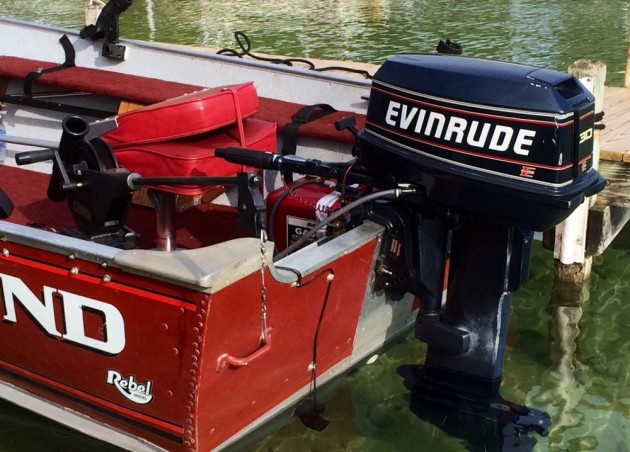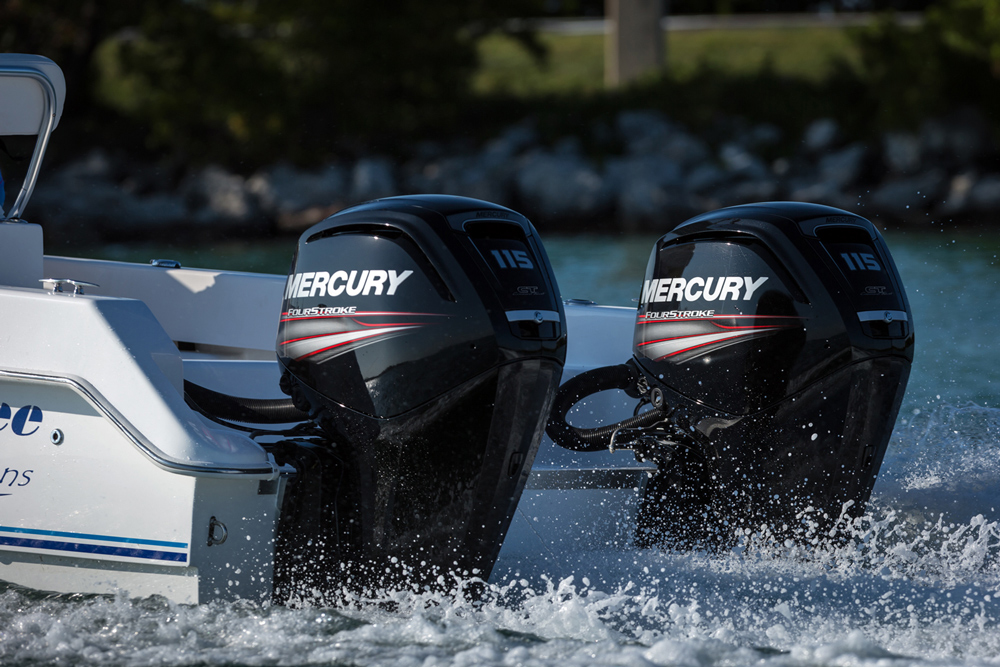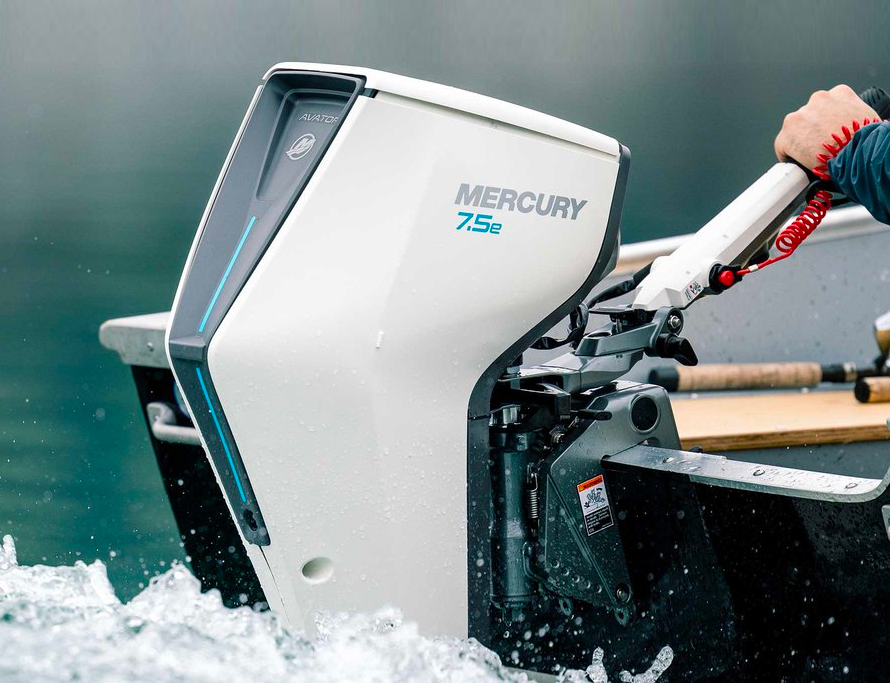Make Your Old Outboard Engine New Again
If your old Johnson, Evinrude, Mercury, Mariner, or Yamaha is giving you trouble, it might just need a little love.
I love the smell of two-stroke exhaust in the morning. And if your outboard was new during the Reagan administration, you know what I mean. Those old outboards were built tough, and plenty of them are still running strong today.
Like anything mechanical, however, an old outboard needs some love. Rubber ages, parts wear, and corrosion runs its course. Pretty soon that faithful old Johnson is letting you down. Read on for some tips to help your old outboard avoid or overcome the ravages of time.
Buy the Book
A service manual can offer valuable guidance on maintenance and repair procedures. Typically available through authorized marine dealers, online service literature dealers, or even eBay, the manual provides instructions on disassembling and reassembling parts, key specifications, and maintenance details, including the location of all lubrication points.
Fuel System
Rubber and plastic components in a fuel system can deteriorate due to various factors such as age, heat, and ethanol. This deterioration can lead to dangerous fuel leaks or the intake of air into the system, causing difficulty in starting or keeping the motor running. Fuel lines are particularly vulnerable to this deterioration process, becoming hard and brittle over time and deteriorating from the inside-out.
It is important to regularly inspect and replace any worn or damaged fuel system components to ensure safe and efficient operation of the motor. Furthermore, using fuel stabilizers and storing the motor properly when not in use can help minimize the impact of age, heat, and ethanol on the fuel system. Regular maintenance and care can prolong the life of the fuel system components and ultimately contribute to a better boating experience.
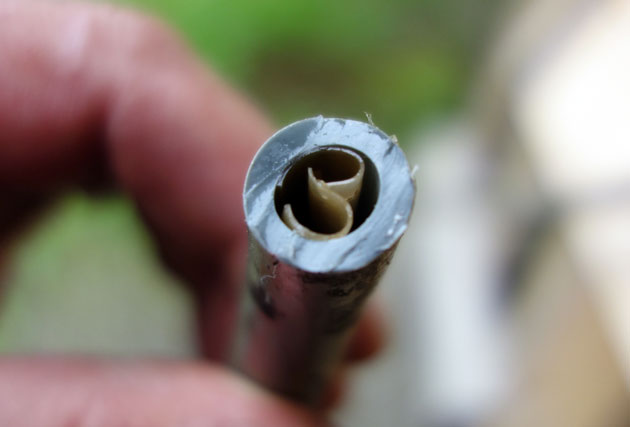
Above: This fuel line is only about 10 years old, but feels stiff. Cut it open and it’s easy to see the inner liner is falling apart, probably from excessive ethanol exposure. This was a problem with the silver-colored fuel line used by Mercury and Yamaha a few years ago. The deteriorating liner will restrict fuel flow and particles can break loose and contaminate the fuel filter or the carburetor. Photo by Charles Plueddeman.
Old or worn-out fuel pump diaphragms and check valves can contribute to difficulty starting an outboard motor. Fortunately, replacing the fuel lines and rebuilding the fuel pump and carburetors with modern, ethanol-resistant components is a straightforward solution.
When replacing fuel lines, it is important to use marine-specific, ethanol-rated fuel line materials. These materials are designed to withstand the corrosive effects of ethanol and minimize the risk of fuel leaks or other fuel system malfunctions. Rebuilding pulse-type fuel pumps and carburetors with kits that include new, ethanol-tolerant diaphragms, check valves, and floats (if needed) is also a good practice.
Once the fuel system has been rehabilitated with these components, it will function at peak efficiency and be much safer to use. Regular maintenance and inspection of the fuel system can help to ensure its continued optimal performance and minimize the risk of fuel-related issues while boating.
Water Pump
The rubber impeller of the water pump in an outboard motor can become dry and stiff with age, particularly if the motor is not frequently used. Even if the motor has seen a lot of hours, the impeller vanes may also become worn or scored. Although you may see water streaming from the tell-tale on the side of the motor, the water pump may not be delivering sufficient pressure to the cooling system. If the pump fails, you may not notice until the motor overheats. Thus, it is advisable to replace the impeller regularly as it is inexpensive insurance.
You should also inspect the pump housing, which can be replaced on many motors if it has been scored by abrasive sand. It is also essential to inspect the water intake port(s) on the lower unit to ensure they are not obstructed by debris, as this can cause the motor to overheat. A stiff wire can be utilized to clear the blockages.
Propeller
Improving the condition of the propeller can significantly enhance the overall performance of an outboard motor. Even if the propeller appears to be fine, it may have slight bends or worn blade cupping, which can cause it to be unbalanced or improperly pitched. These issues can impact the motor's performance and fuel efficiency. Therefore, it's essential to inspect the propeller's condition regularly.
If the propeller is damaged or in poor condition, a replacement or repair is necessary. A prop shop can use a jig to check and tune up the blade alignment, which helps improve the propeller's balance and performance. Moreover, advancements in computer-aided design have improved propeller design significantly in the past few decades. Hence, upgrading to a newer model could make a noticeable difference in the motor's efficiency and speed.
It's crucial to note that propellers are not indestructible, and damage to the blades may not always be visible to the naked eye. Therefore, it's vital to inspect the propeller for any signs of wear or damage, especially after encountering a soft bottom or other obstacles in the water.
While you’ve got the prop off the motor, check for fishing line wrapped around the shaft near the propshaft seal; it can destroy that seal and let water enter the gearcase.
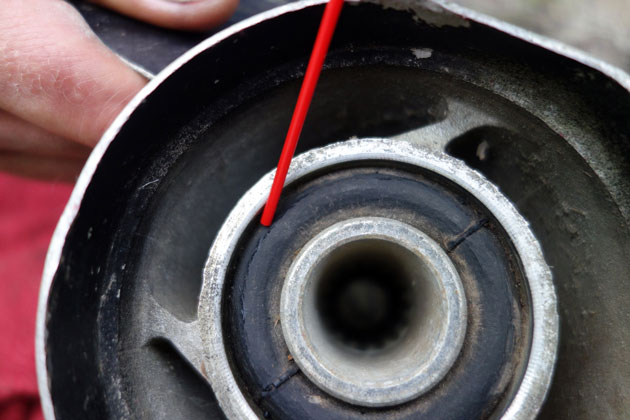
Above: Note the small cracks forming in the dried-out rubber hub cushion of this propeller. The rubber also feels hard when pressed with a fingernail. It’s possible to get the hub replaced, but a fresh prop might be a better investment in the long term. Photo by Charles Plueddeman.
The really weak link on an old prop is the rubber hub cushion. Like the fuel system and the water pump impeller, the rubber hub material gets hard and dry as it ages and is constantly exposed to hot and acidic exhaust. The bond between hub splines and the barrel of the prop can fail when the hub material dries out, leaving the propshaft disconnected from the prop. Beware an old prop from dealer stock—a marine tech I know thought he’d struck pay dirt when he found a 30-year-old NOS stainless-steel Mariner prop for his 25 HP motor, gathering dust in a dealer stockroom. Even though it was “NOS” (new on shelf) the hub was dry and spun out the second time he used the prop.
Spark Plugs and Wires
Most outboard owners know to throw a new set of plugs in a two-stroke outboard every season. But like everything else rubbery on an outboard, heat and ozone will cause the spark plug wires or cables to age with time and they should also be replaced. Old wires will feel stiff or brittle, and will develop small cracks in the insulation that can allow current to arc out of the wires. One way to check for arcing is to start the motor in the dark with the cowl off, and look for white or bright blue flashing where the current is escaping the cables and grounding somewhere on the motor. New plug cables will ensure all that current reaches the plugs.
Rebuild the Recoil
If your motor has a manual rope-start (the so-called Armstrong System), it will likely benefit from a rebuild. Mounted on top of the powerhead, the recoil is exposed to a lot of engine heat, and also gets baked in the hot sun, especially under a black cowl. The lubricating grease gets old and waxy, and the entire mechanism can become polluted with dirt and minerals from the water. The rope itself will age and get stiff and become prone to breaking, usually at its end where it’s crimped around the spool or pulley.
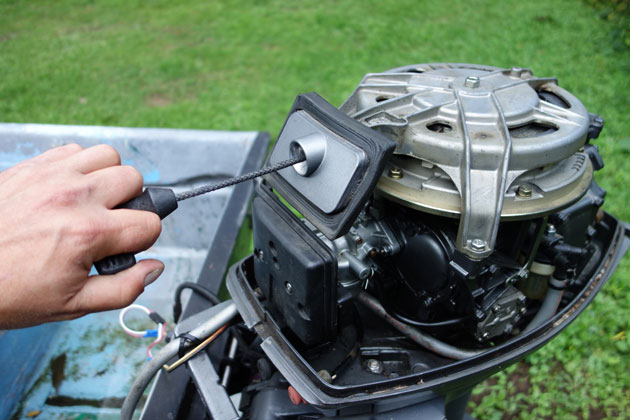
Above: A clean, well-lubricated recoil starter is a pleasure to use. To inspect the rope, pull it out all the way. If it’s frayed or stiff, it should be replaced. Photo by Charles Plueddeman.
The service manual will be especially helpful for this task, as the recoil often has a number of small parts and a spring or two to deal with. Get it apart and use solvent to clean off any old grease. Replace any parts that appear worn, like rope guides or pawls that grip the flywheel. Re-lube and then reassemble with a new rope or cable.
Finally, give that old outboard a hug—everyone needs some love now and again.
Editor's Note: This article was originally written in September 2015 and last updated in April 2023.
